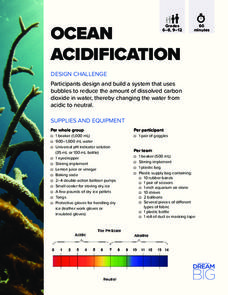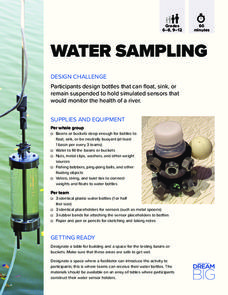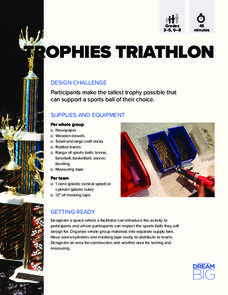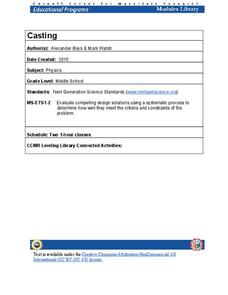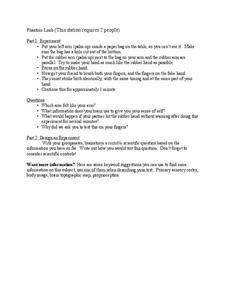DiscoverE
Ocean Acidification
Combat ocean acidification with bubbles. Young engineers create a system that reduces the acidity of water. Dry ice in water helps simulate ocean acidity, and blowing bubbles into the water results in a gas exchange that neutralizes the...
DiscoverE
Water Sampling
What is the best way to test water quality? Using plastic bottles, scholars create monitoring sensors to test water quality. Creating three different sensors allows individuals to measure water quality at different water levels.
DiscoverE
Trophy Triathlon Design Challenge
Build a trophy and be a winner. Pupils build trophies that can support a sports ball of their choosing. Based on the ball choice, they figure out how the height requirement changes.
DiscoverE
Extreme Trampolines
You'll bounce off the walls with glee after finding a fun resource. Young engineers design trampolines for golf balls. They build and test out their design and make improvements based on the results.
DiscoverE
Tape Dispenser Challenge
Help your class get out of a sticky situation! Future engineers explore existing tape dispensers and then design a new system for dispensing tape. To put these systems to the test, they build and evaluate prototypes of their designs.
DiscoverE
Sorting Solutions
It's okay to play with your food—just this once! Scholars design and create meshes and chutes to sort pasta by size and shape. They test their designs and make improvements as necessary.
Cornell University
Casting
Don't cast a great hands-on resource aside! Scholars learn about the process of casting by actually trying out an example. Plaster of Paris and cookie cutter molds help them complete the activity.
Norwich University
Seven Man-Made Engineering Wonders of the Ancient World
Imagine precisely cutting and then moving a 120 ton boulder more than two miles without mechanical cutting tolls, skid loaders, or hydraulic cranes. Imagine carving a stone figure that includes a drainage system that permits rainwater to...
NOAA
Invent a Robot!
Wait til your class gets their hands on this! Aspiring engineers design a working robotic arm in the fifth and final installment in a series of ocean exploration lessons. Pupils learn about the use of underwater robots in ocean...
NPR
Share and Reflect
Would you have done anything differently? Groups publish one-minute videos on their engineering solutions to the plastic problems. They self-reflect on their work throughout the unit.
NPR
Communicate the Solution
Communication is key. Scholars produce videos to highlight their engineering solutions to the plastic problem in the ninth installment of the series of 10. Feedback from other groups lets them improve the videos.
NPR
Iterate to Improve the Prototype
Strive for perfection. Based on peer feedback, groups identify ways to improve their prototypes of the solution to the plastics problem. Members must come up with at least two ideas for improvements. This is the eighth instructional...
NPR
Test and Evaluate the Prototype
Time to test the prototype. Groups test their prototypes to the plastics problem under consideration. The results of the tests and peer feedback offer a means to refine the prototype.
NPR
Prototype the Solution
It's always nice to see what the solution looks like. Groups build a prototype of their solution to the plastics problem in the sixth installment of a 10-part unit. The prototypes can be either a visual prototype or a working prototype.
NPR
Brainstorm and Evaluate Solutions
May the best idea win. In groups, scholars brainstorm solutions to the problem statement developed in the previous instructional activity. The best idea moves forward to the prototype stage.
NPR
Identify Criteria and Constraints
What defines success? The fourth installment of a 10-part series focuses on the criteria for engineering design success in solving the plastics problem. Pupils also consider any constraints.
NPR
Define the Plastic Problem
Individuals identify a specific problem concerning plastics and write a problem statement, which describes the problem, explains why it's a problem, and identifies desired solutions.
NPR
Investigate the Plastic Problem
Plastics are forever. The second lesson plan in a 10-part unit has pupils research the effects of plastics on the environment. They present their findings by creating an infographic.
NPR
Introduction to the Engineering Design Process
Step by step is always best. In groups, future engineers create the tallest possible tower with marshmallows and spaghetti sticks. Along the way, they learn about the engineering design process.
Discovery Education
STEM Camp—Urban Infrastructure
Build a bridge to learning in a STEM-aligned unit about urban infrastructure. Young engineers explore the many aspects of civil planning and design in a five-day unit. Content includes the challenging aspects of balancing building with...
University of Minnesota
Neurotransmission Model
Don't lose your marbles — you'll need them for a lesson on neurotransmission. Young scholars build a neurotransmission model using marbles, beads, rubber bands, string, and other elements. After studying specific neurotransmitters,...
Scholastic
STEM Challenges and Activity Sheets 3–5
How can engineers help their communities? Three challenges in the first unit explore why STEM is important to communities and how neighborhoods are engineered to experience those benefits. The second unit prompts groups to plan an...
University of Minnesota
Phantom Limb
A phantom of neuroscience may leave pupils perplexed as they engage in an experimental lesson that recreates a phantom limb scenario. After experiencing the phenomenon, they choose a scientific question to explore further.
Scholastic
STEM Challenges and Activity Sheets for Grades 6–8
From 3-D cities to building bridges, young engineers engage in innovative STEM challenges that promote brainstorming and collaboration. Learners take on the roles of different types of engineers as well as become familiar...
